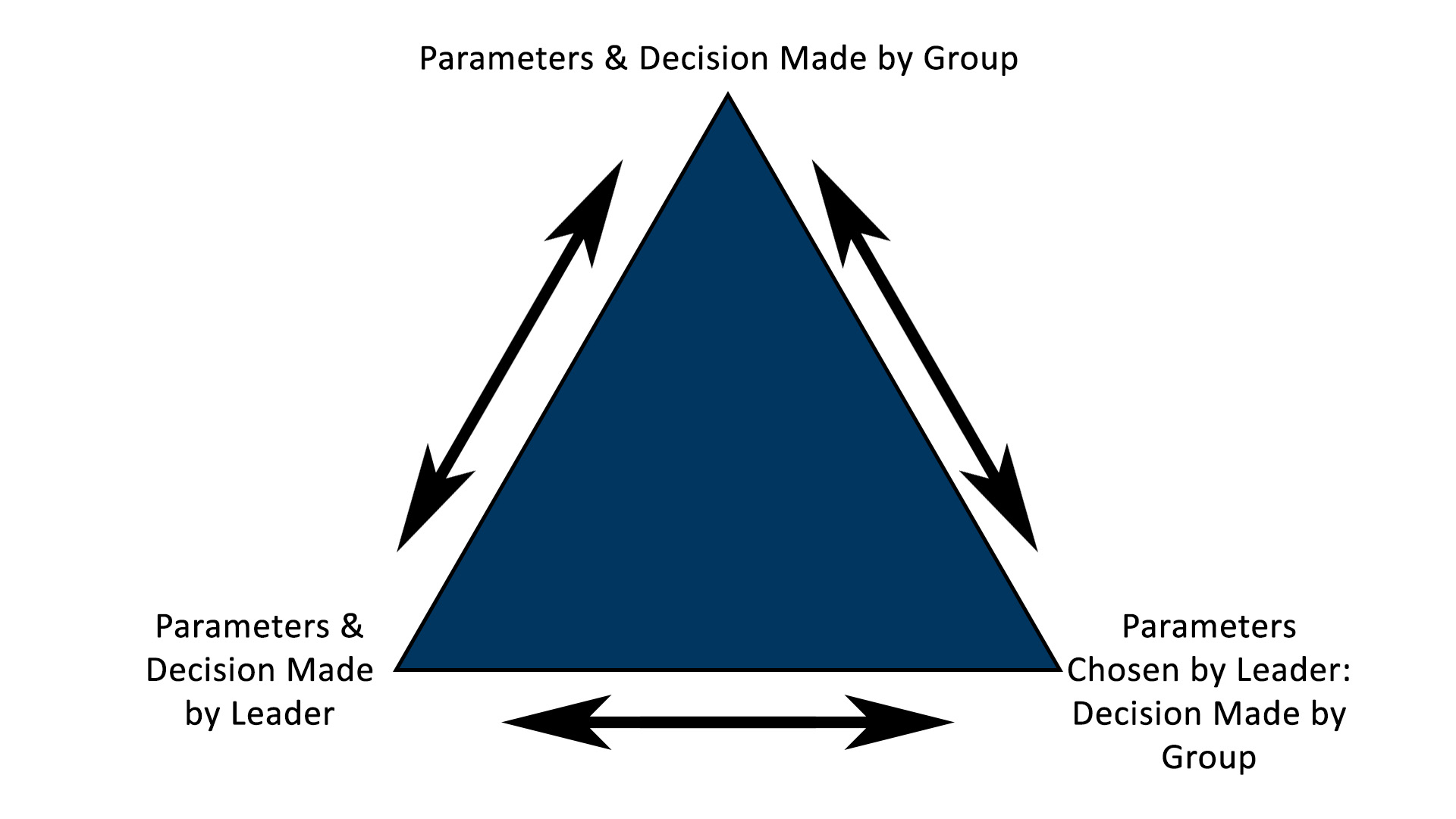The Decision Making Triangle
Learning Objective
To demonstrate a model for group decision-making processes and explore how variations in approaches can significantly impact outcomes.
Introduction
In this chapter, we will explore the “Triangle Model” as a framework to comprehend the roles of leaders in the decision-making process. The model offers insights into setting decision-making parameters and understanding the locus of control to effectively influence decisions made in dynamic environments.
Understanding Parameters as a Factor in Decision Making
Parameters serve as essential guidelines that define the scope and boundaries of various processes or activities, and influence the permissible range of decisions made by a group. Parameters in decision making, include legal, safety, organizational policy, and certification limits.
Outdoor leaders play a pivotal role in shaping the decision-making dynamics of groups, often while navigating the balance between empowering participants and maintaining safety. Some parameters come from safety protocols such as crossing length or rapid rating, PFDs, or weather forecasts. Other parameters come from instructor knowledge and experience – for example, optimal flow of a day or route section; local knowledge about break spots and travel times; or the level of terrain difficulty that is allowable to navigate.
Example QuestionsIf a two nautical mile ocean crossing is the maximum length of crossing stated in the organization’s standard operating procedures, then can a group decide to make any crossing under that length? Yes. Depending on what other parameters, risks and hazards are present, anything under the maximum length can be considered. Can the group cross anything wider than two nautical miles? No. This is outside the defined parameters. Can a group decide when/where/if they have lunch? Possibly. If there is a long exposed section after lunch, then maybe the parameter is lunch has to come before the exposed section. This is a safety parameter you have put in place.
|
|---|
When offering a group more decision-making power, you must be clear on what parameters are appropriate to let go of and what parameters you maintain control over. As noted above, many parameters will be pre-defined by organizational policies and risk tolerance, the educational goals of the program, your scope of practice and industry standards. Others will be defined by your own level of comfort, skill and risk tolerance (i.e. are you ok to have a late lunch if your group takes a wrong turn and delays getting to a good lunch spot?). It is also important to consider why you control certain parameters – is the parameter there to increase safety, or is it for your personal preference for doing things a certain way?
As a leader it’s important to be clear on whether you are offering a group the opportunity to make real choices or not. Be transparent about the choices that you are offering and why, so groups feel empowered in understanding their scope and influence. Keeping the objective hazards involved, the skill level of the group and your professional responsibility for the safety of your group in mind at all times.
Three Corners
Take a look at the diagrams below. Take a look at the each point of the triangle.

The three points of the triangle above show the amount of decision making power given to the group and the leader – both in selecting the parameters of a given decision and the agency to make the final decision itself. It is rare that we will actually be at the far corners of the triangle – most of the time we will be somewhere along the continuum between each of the corners.

In these types of scenarios, it can make sense for both the Parameters and Decision to be made by the leader:
- Urgent/emergent decisions: time sensitive
- New group and not yet functioning as a team to make decisions
- Set learning outcomes or goals that need to be guided by leaders
- Safety concerns
- In terrain beyond the current ability or experience of the group

Certain situations call for a balance between leader-guided decisions and group involvement. Here are scenarios where leaders set parameters while allowing groups to make decisions:
- Group is ready for some decision-making but still require a safety net
- Leader establishes safety parameters to prevent high-risk decisions.
- Group is encouraged to actively participate in decisions.
- Leader intervenes if safety is compromised, providing a safety net.
- Significant positive impacts to the group and learning experience (autonomy, mastery, skill and leadership development)
- “Natural consequences” as learning opportunities
- Group experiences the natural consequences of decisions, reinforcing learning.
- Leader intervenes if decisions pose significant risks or deviate from safety.

The following scenarios are examples of conditions when both the Parameters/Decision could be made by the group:
- Engaging in a fun social activity during a non-critical phase of the outdoor experience.
- Low impact of the decision on safety or program objectives.
- Time flexibility allows for unhurried group discussions.
- Fosters a relaxed and inclusive atmosphere, promoting enjoyment.
- A highly functional and skilled group
- Group members possess advanced skills and experience.
- Decision complexity aligns with the group’s competence.
- Capitalizing on individual strengths enhances overall decision quality.
- Desire to increase buy-in to the decision being made
- Group consensus and commitment are pivotal for the success of the decision.
- Training courses, such as instructor or guide training, where decision-making aligns with skill and educational levels.
- Decision complexity matches the educational objectives.
- Group members possess the necessary skills
- Learning outcomes are reinforced through hands-on involvement in decisions
When you’re on an outdoor journey, a helpful exercise is to consider where different decisions you have made fit on the diagrams above. Think of a few examples of types of decisions that would get made in different areas of the triangle.
Checkpoint: Decision Making Triangle
Experience, Efficiency, and Buy-in
The effectiveness of decision making in outdoor environments is influenced by a number of factors including , the level of experience (of the staff team and the group), how much efficiency is needed in making certain decisions, and the level of group ownership or buy-in you need or want to facilitate.
As general rules of thumb:
- You and the group need more experience, training, knowledge and skill when parameters/decisions are made by the group.
- Having the leader choose both the parameters and decisions made by the leader increases efficiency.
- Ownership or Buy-in generally increases as you move towards the corner of the triangle where both parameters and decision being made by the group.
To Consider
- Experience: How can experience affect each of the points of the decision making triangle? How do you choose what the most appropriate decision making approach is when making a decision with less or more experienced leaders and/or groups?
- Efficiency: When is it important? What can improve it? Generally when the parameters and decision are solely controlled by the leader, decisions are more efficient, however more experienced and skilled groups can become quite efficient at making decisions.
- Effect of Ownership or Buy-in: How do the three decision making models relate to buy-in? Based on who the leader is and what the group dynamics are, how can buy-in shift and why. For example Buy-in generally increases as you move towards the top of the triangle, however if the leader makes the decision and that leader has the group’s support and trust, the buy-in can be just as high as if the group had made the decision.


